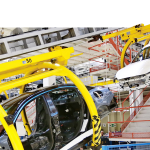3 types of automation transforming the enterprise today

- Organizations are leveraging automation to increase productivity and achieve greater impact
- An increasing number of organizations is recognizing the value of automating tasks due to the pandemic
- Here are three ‘types’ of automation that businesses are adopting
The word automated finds its roots from the Greek word automatos, which basically means “acting of oneself.” While the meaning of the word is self-explanatory, it is widely associated with manufacturing and industrial work, thanks to Ford Motor Vice President Delmar S. Harder coining the term automation in 1948.
Today, the concept has extended its breadth to almost all areas of work, from the machinery running on farmers’ fields, to the back-office IT systems at global insurance firms. Finding ways machines can take on work previously designated to human workers is one of the core facets of digital transformation initiatives. The goals lie in freeing up workers from mind-numbing repetitive tasks for more valuable input, reducing errors and downtime, saving costs, and driving a competitive advantage as a result of the combination of all.
The COVID-19 pandemic has highlighted how this technology can keep the business running faced by a reduced workforce capacity, whether through the necessity of redundancies or furloughing, or because lockdown restrictions mean workers can’t access sites. The spotlight is such that a new wave of organizations are now exploring its potential. Interest in automation technology by the arts and culture sector, for example, has risen from 25% of companies ahead of the pandemic to 75% today.
Similar trends have been seen in the education, healthcare, and retail sector, indicating how this next-gen technology can enhance operations in the years to come. Here are three kinds of automation set to continue finding their place within the enterprise.
# 1 | Robotic Process Automation (RPA)
RPA entails a software robots undertaking repetitive and mundane tasks that don’t take a lot of skill. Essentially, they are programmed individually to move data from point A to point B, following the same path and actions that a human would take.
RPA’s relatively low cost and quick implementation could see it one of the key technologies adopted in the mid-term, Gartner acknowledges that it is just one of a number of emerging AI technologies that is helping healthcare organizations which are mired in legacy technology. By 2023, 20% of all patient interactions will involve some form of AI enablement within critical or nonclinical processes, up from less than 4% today.
The RPA market – made up of numerous players like SAP, Pegasystems, UiPath, Another Monday and Cognizant – is expected to net US$12 billion by 2023, up from US$5 billion in 2019.
The goal of RPA is to free up valuable employee’s time to manage other more complex and ‘creative’ tasks. Imagine scenarios of validating data associated with a client’s profile, processing financial claims, handling payrolls, and automatically storing and backing up data. With RPA modeled into organizational procedures, businesses can save a monumental amount of resources and free up valuable manual power. For instance, insurance company AXA reported close to US$200K and 18,000 of productivity hours saved after deploying 13 RPA scripts.
# 2 | Workflow automation
Workflow automation creates automated actions for each step of a business process, with software that is capable of pushing a task through a business by one step, or several steps, and sometimes in entirety. Automation works best on repetitive and relatively structured or semi-structured tasks. The more unstructured tasks are, the harder they will typically be to completely automate without human interaction.
To provide an example, recruitment can be partially executed through workflow automation. Bart Turczynski at online resume company uptowork explains that a company automating at this level will first need to set up a web ‘landing page’ that lists job openings. “For most candidates, especially interns, a pipeline flow can be set up that automatically replies to the incoming applications, archives their submissions, notifies the person responsible, forwards crucial information to the candidate and puts them in touch with the delegated staff member. A quick phone call is then scheduled. Hence, a chunk of workflow has been automated,” said Turczynski.
Workflow automation software can help remove cluttered, inefficient processes from the business. It’s not hard to see how this technology could be pushed further. Even in the above example – why not assign potential candidates with a ‘forms-based’ questionnaire and execute another step in the recruitment process through automation?
YOU MIGHT LIKE

How automation could snag 36 million jobs in a recession
# 3 | Code automation
Continuous integration (CI) and continuous delivery (CD) relate to code automation. The adoption of CI and CD in combination will ensure the delivery of quality software through orchestrated pipelines, streamlined by automated processes. In simple terms, CI is “the practice of merging all developers’ working copies to a shared mainline several times a day.” This developmental practice is to prevent “integration hell” from breaking loose when developers face difficulty in integrating new codes to the repository due to drastic changes made to the baseline codes.
CI maintains the code repository with regular integrations and, in the long run, enables developers to detect errors quickly as each change introduced is generally small, saving hours of productive time.
Meanwhile, CD refers to keeping applications deployable at any time by automatically testing and validating changes made to code. CD ensures all configurations are in place, and applications are ready to be pushed for testing or production immediately, creating a fast development loop.
In essence, CI/CD allows developers to autonomously test new ideas, optimize workflow, which in turn, accelerates innovation.
Different types and approaches to automation will bring various benefits to organizations, but collectively, automation at its core is here to boost an organization’s speed and productivity. But it’s worth remembering a quote from Bill Gates: “The first rule of any technology used in a business is that automation applied to an efficient operation will magnify the efficiency. The second is that automation applied to an inefficient operation will magnify the inefficiency.”









